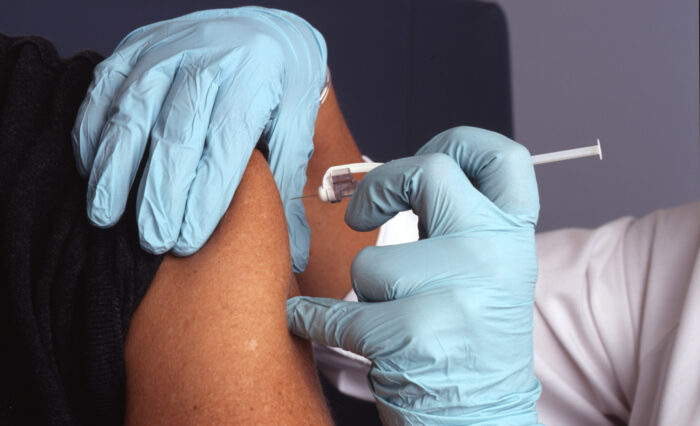
Dr. Kathryn Malin is an assistant professor in Marquette University’s College of Nursing and a neonatal nurse practitioner at Children’s Wisconsin. She answers some frequently asked questions about RSV, COVID-19 and influenza — from symptoms to watch for to ways you can be proactive and protect yourself and your loved ones.
Let’s begin talking about a disease that we commonly hear affects young children and babies. What is RSV and how does it affect children? Also, what are the symptoms parents should be looking for?
“RSV” stands for respiratory syncytial virus. It is a common virus that causes respiratory illness, most commonly in children. Common symptoms include runny nose, cough, sneezing, fever, decreased appetite and fatigue. Most people will have an RSV infection by the time they are 2 years old. For most children, an RSV infection lasts about one week, and management includes things like taking over-the-counter fever reducers, drinking enough fluids and resting. For some children, though, RSV can become a very serious infection that requires hospitalization. Children who were born prematurely or have other medical conditions, such as asthma, are at a higher risk for developing inflammation of the airway and pneumonia from an RSV infection. In these children, symptoms such as trouble breathing need to be treated immediately at a medical facility.
How do you know when it’s time to take your child to the doctor or hospital?
For most children, RSV resolves with time and parents do not need to take their child to the doctor or hospital. If your child is having a difficult time breathing, isn’t drinking enough fluids or if symptoms get worse (e.g., higher fevers), you should take them in to see a health care professional.
What can parents do to protect their children from getting the virus?
Since there is no specific treatment for RSV, the best thing parents can do is help prevent their children from catching the virus. Just like with other respiratory viruses, there are a few basic measures everyone can take to help protect against infection. These include avoiding close contact with sick people, frequent hand washing, masking when appropriate, covering your coughs and sneezes, avoiding touching your face, disinfecting surfaces, and staying home when you are sick.
Are you seeing that hospitals are having a hard time keeping up with the number of patients who need care from viruses like RSV, COVID-19 and the flu? How are hospitals preparing for the uptick in patients?
Pediatric hospitals all over the country are having a difficult time managing the large influx of children who are sick with viruses. It is not just RSV that we are seeing in the sick children at our hospitals. Rates of influenza, strep A and COVID-19 are all high right now. While hospitals are certainty capable of caring for children sick with any of these viruses, it is the sheer number of sick children at the same time that is making it difficult to manage. Hospitals have reported record numbers of sick patients in their emergency departments and as a result, there is limited bedspace and staff available. The national nursing shortage is making the situation more difficult. To prepare for this surge of sick people, hospitals have put protocols into place to address staffing shortages. Relying on travel nurses and mandated overtime has become normal occurrences. Also, implementing processes that were developed during the start of COVID-19 pandemic are taking place to prepare for the uptick in patients. Nontraditional patient care spaces are being transformed to help manage the need for more bed space.

Some people are calling the confluence of COVID-19, the flu and RSV a “tripledemic.” Which illness are you most concerned about in children and adults.
I am concerned about all three of these viral illnesses. They all have the potential to cause severe illness, especially in people who have other medical conditions or who have not received vaccines (in the cases of COVID-19 and flu).
Let’s move on to how the flu is affecting people this year. Some doctors are saying that 2022-23 is being considered the worst flu season in more than a decade. Why are we seeing a greater number of flu cases this year?
It is true that we are experiencing a severe flu season this winter. We are coming out of the last two years having had implemented significant protective measures to limit the spread of COVID-19. Things like mask wearing and social distancing played an important part managing the COVID-19 pandemic. Along with decreasing the spread of COVID-19, these protective measures also limited the spread of the typical seasonal viruses such as flu and RSV. Now that people have returned to typical activities, such as large gatherings, the spread of these viruses is ramped up. For many young children, this year is the first time they will be exposed to RSV and flu, making the numbers of children who have no previous immunity higher than in previous years.
What do we need to know about this year’s strain of the influenza virus?
Right now, influenza A (H3N2) is the most dominant strain of flu spreading in our communities. Influenza A is known to be associated with more severe disease in very young children and older adults, making this year’s strain particularly brutal. The good news is the flu vaccine appears to be a good match against the strains of flu circulating. The bad news is that the numbers of people who have received the flu vaccine is much lower than in previous years. Rates of vaccination in people who are at high risk for severe illness and complications from a flu infection are also down, which is very concerning.
How do you know if it’s the flu or just a bad cold?
It can be really difficult to know if it’s the flu or a bad cold because both cause many of the same symptoms. In fact, in many cases, people may never know if their illness was the flu or a “cold.” Respiratory illness from many other viruses cause the “common cold” and both the flu and cold lead to symptoms like congestion, fever and headache. In general, though, the flu causes more severe symptoms. Typically, in cases of a cold, people report mild symptoms like a runny nose, whereas people with the flu are more likely to report a fever, body aches, sore throat and general fatigue.
How important is it to get the vaccines available whether it’s for the flu or for COVID-19?
It is so important that people take the vaccines for the flu and COVID-19. I can’t emphasize this enough. Both vaccines provide the best protection available against serious illness from both viruses. Vaccines are safe and easy to obtain. It is important to remember that getting vaccinated not only helps decrease the risk of illness for yourself, but it also helps fight the spread of virus in the community and decreases the risk of illness in those most vulnerable.
Is there anything else that people should know about RSV, COVID-19 and the flu?
Viral season is the time to take care of ourselves. We all need to get enough sleep, stay hydrated and avoid going out when sick. We have all been through so much these last few years with the COVID-19 pandemic. People know more about viruses and how infections are spread than in the past. I think we can use all that we have learned to help keep ourselves healthy during the viral season as well.



